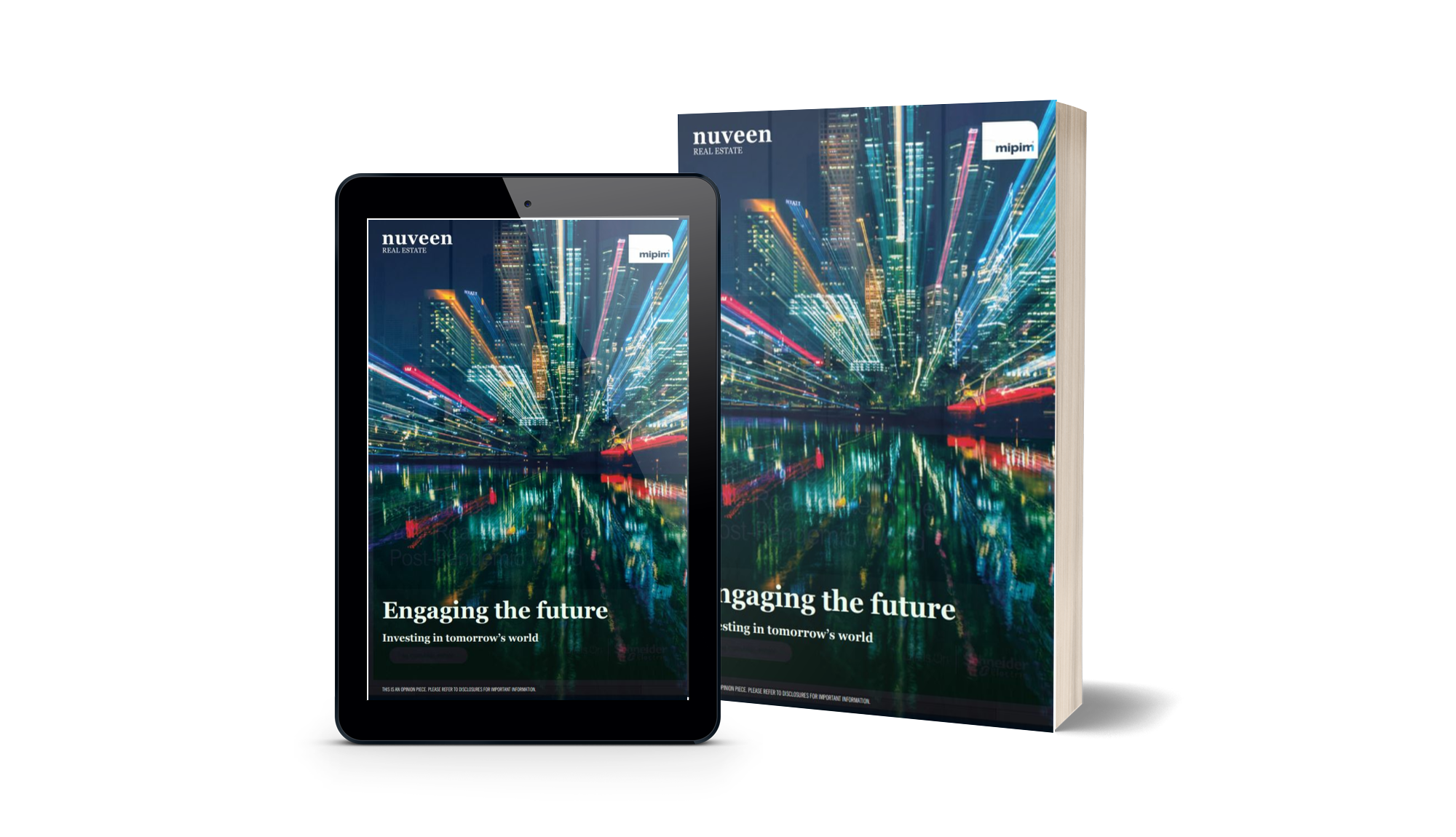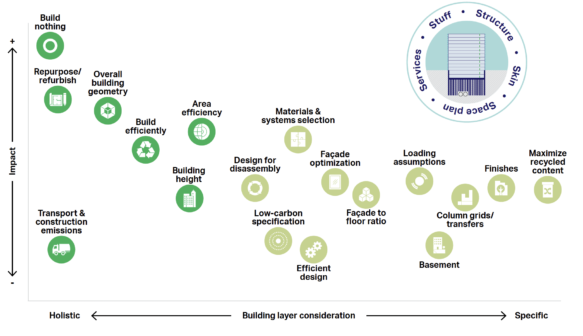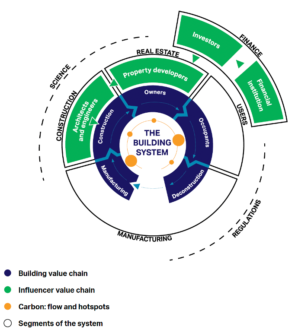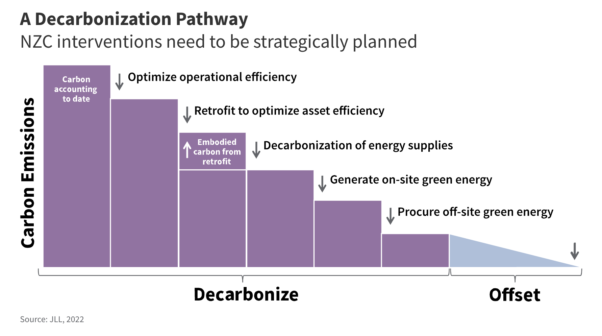A group of intrepid riders from the real estate industry is setting out on 8 March to cycle from London to Cannes in a quest to raise money for charity. Once they get to MIPIM, a much bigger challenge awaits them and the 23,000 other MIPIM delegates – how to transition the built environment to net-zero carbon emissions by 2050.
Road to Zero by MIPIM, a dedicated programme within MIPIM 2023, is gathering some of the biggest names in the decarbonisation transition: the Urban Land Institute (ULI), the World Green Building Council (WorldGBC), the World Business Council for Sustainable Development (WBCSD) and the Institutional Investors Group on Climate Change (IIGCC).

Engaging the futur
Investing in tomorrow’s world
This impressive line-up reflects the immensity of the challenge. Accounting for nearly 40% of all emissions, the built environment is one of the world’s largest emitters of carbon, notes McKinsey – a challenge too big for any one organisation, company, sector or government to solve.
All challenges need a vision. For decarbonisation, the vision is to halve carbon emissions by 2030 and to reach net zero by 2050, in line with the 2015 Paris Agreement. This is set to keep the average rise in global temperatures to below 1.5oC of pre-industrial levels. If we breach that level, the outcome is predicted to be catastrophic, for all of us.
The message from the leaders speaking on the Road to Zero Stage at MIPIM 2023 is united: the road to net zero is about collaboration, sharing and creating transparency along the entire value chain of the built environment.

Lisette van Doorn, CEO of ULI Europe, the co-organiser of the conference programme of Road to Zero by MIPIM
Halving carbon emissions by 2030 and net zero by 2050
“We’re in this together. Markets are starting to move. Change is around the corner. There are now no more excuses not to act on decarbonisation,” says Roland Hunziker, director built environment at WBCSD, which represents over 200 of the world’s top corporates, all signed up to the Council’s Vision 2050 road map.
We’re coming to MIPIM as we want to engage with the industry on the opportunities of this transition – Roland Hunziker of WBCSD
WBCSD members commit to setting an ambition to reach net zero greenhouse gas emissions (carbon is just one such gas) by no later than 2050 and to have a ‘science-informed’ plan, such as the Science Based Targets initiative, to achieve it.
“Every single company is in the ‘race to zero’, and they are addressing their emissions through Scopes 1, 2 and 3 as they actively search for solutions to decarbonise their operations,” says Hunziker. “We’re coming to MIPIM as we want to engage with the industry on the opportunities of this transition.”
Key overarching considerations – whole-building decisions

Source: Net-zero Buildings: Halving construction emissions today by WBSCD and supported by Arup (2023)
First things first. What is net zero?
The world has only seven years to halve carbon emissions from the levels of 2010. The not-so-good news is that global carbon emissions from building and construction are at an all-time high, according to the UN’s 2022 Global Status Report for Buildings and Construction.
Emission intensity has reduced (7% since 2015), but energy efficiency has only marginally improved (0.7% since 2015), with any gains outpaced by the 11% building floor growth over the same period.
There’s no universal definition of a net-zero building, but the calls from the likes of the ULI, WBCSD and WorldGBC are for a whole-life carbon approach – one that addresses both operational and embodied emissions.
To talk about net zero, we also need to talk about the role of the circular economy as an enabler of cutting carbon emissions and resource use, adds Hunziker, and to link in to the two other big global challenges of nature loss and social inequality.

Roland Hunziker, director built environment at WBCSD: “We also need to talk about the role of the circular economy.”
The difference between leaders and laggards in the race
When it comes to cutting carbon, the industry grasps the scientific understanding: 93 per cent of real estate leaders said running an environmentally and socially sustainable business was the most important factor for successful organisational transformation over the next 20 years, revealed the PwC/ULI report 2023 Emerging Trends Europe.
The technology also exists to achieve net zero. Manish Kumar, EVP Digital Energy, Schneider Electric, which has developed a proven three-step pathway Retrofitting Buildings for Sustainability, provides the answer: “We don’t have a technology solutions gap – there is a gap between ambition and action.

Manish Kumar, EVP digital energy, Schneider Electric, who is speaking at MIPIM
Too many organisations want to be more sustainable, but they are not prioritising the most effective initiatives, in part due to a lack of understanding, says Kumar.
We don’t have a technology solutions gap – there is a gap between ambition and action – Manish Kumar, Schneider Electric
“Organisations who are leaders in sustainability understand the connection between more sustainable buildings and improved efficiency, resiliency, occupant experience and reduced energy costs – they see the whole picture and the benefits,” he says.
Those players who don’t understand the broader business value list “budget and financial concerns” as the key hurdle they’re facing, adds Kumar.
Another significant difference between leaders and laggards, says Kumar, is that leaders aim to get ahead of the game, including taking voluntary action in advance of any regulatory compliance scheme. (See below for more about the regulatory framework.)
We are living the Age of Resilience … and other connected qualities
A key word in the transition to net zero is the need to build resilience. MIPIM opening keynote speaker Professor Jeremy Rifkin writes in his latest book about the current transition from the Age of Progress to the Age of Resilience.
The Age of Resilience is about “adaptivity” rather than efficiency, writes Rifkin. He looks to the semiconductor industry, a sector dominated by a handful of “giant corporate heavy weights” who have survived the competition by “cutting costs across their operations with lean logistics and manufacturing processes” at the expense of being “less ‘resilient’ and vulnerable to unexpected events”, as was born out by the global shortage of semiconductor chips in the aftermath of Covid.
Looking at the built environment, Kumar of Schneider Electric says: “Adaptivity is directly linked to resiliency, but it’s not the only thing that matters.
“Buildings of the future are resilient, sustainable, people centric, and also hyper efficient,” explains Kumar. “These qualities are all connected and any organisation that is progressing along their journey to net-zero buildings will reap the benefits of all of them.”
As an example of a building that is resilient, sustainable, people-centric and hyper-efficient, Kumar cites the new Terminal One at JFK International Airport, where Schneider Electric is working in a joint venture with the Carlyle Group. Among other features, the terminal – due to open in 2026 – is able to function off-grid during power outages.

A building of the future: the new JKF International Airport Terminal
Data and the landlord-tenant dilemma
“The road to net zero is all about transparency, and data is the foundation on which to build transparency,” says Sam Pickering, executive director for sustainability at workspace adviser Incendium Consulting, part of The Instant Group.
When it comes to data, we have the technology. ESG data management specialist BuildingMinds, for example, integrates building and portfolio data into a single platform that allows benchmarking against environmental, social and financial KPIs. The company is currently working on the innovation campus of its founding partner, Schindler.
Data on its own is not enough. In the landlord-tenant relationship, for example, data needs to be shared in order to reach those who take the decisions that lead to a reduction in carbon emissions.
“Even though traditional lease lengths have tended to get shorter, the way of working between landlord and tenant still lacks any real collaboration,” says Pickering of Incendium Consulting.
“Too often, we sit behind a LEED assessment or a BREEAM assessment but don’t necessarily provide the transparency and the performance that will drive us to halve emissions by 2030,” he explains.
Invariably the sharing of data is no more than a clause within a standard lease, and more often than not it gets scrubbed out – Sam Pickering, Incendium Consulting
And then there is the issue of the ‘green’ lease. “People talk about green leases, but invariably the sharing of data is no more than a clause within a standard lease, and more often than not it gets scrubbed out at the point of agreeing contracts,” adds Pickering.
A strong call to action for companies is to get around the table and work on these issues, agree to share data and agree to invest in upgrading – Roland Hunziker, WBCSD
The WBCSD is currently working on a paper to provide a global overview of green leases. “There needs to be a higher level of ambition,” says Hunziker.
“More and more companies have net-zero targets, and the buildings they occupy are part of these targets. A strong call to action for companies is to get around the table and work on these issues, agree to share data and agree to invest in upgrading.”
Building and construction system value chains

Source: Net-zero Buildings: Halving construction emissions today from WBSCD and supported by Arup (2023)
Inform, train, educate – the mantra for helping decision making
Given that data is not always forthcoming in the industry, real estate professionals are used to making decisions without having full access to data, says Sarah Dominey, finance & built environment manager, WBCSD.
The more we can inform, train, educate everybody working in the industry … the more impact they might have – Sarah Dominey, WBCSD
With the industry’s ambitions for the role of data so high, her concerns are that these ambitions will not be achieved and that, given the amount of information increasingly required, professionals are increasingly moving outside their sphere of professional knowledge.
“The more we can inform, train, educate everybody working in the industry, the more comfortable people will feel and the more appropriate for them to make assumptions around the solutions, and the more impact they might have. Once again, it comes back to sharing, collaboration and transparency,” she explains.

Sarah Dominey, finance & built environment manager, WBCSD: “It comes back to sharing, collaboration and transparency”
Regulation is happening but not fast enough
To keep to the 1.5 °C pathway, all countries need to have begun regulating embodied carbon by 2025, says WorldGBC.
In this respect, Europe is leading the way, says Audrey Nugent, director of global advocacy at WorldGBC, which in 2018 launched the Net Zero Carbon Buildings Commitment.
A revision of the main EU piece of legislation governing building sustainability, the Energy Performance of Buildings Directive – which includes the introduction of whole life carbon limits for new buildings – is currently awaiting approval from the EU Council and the European Parliament, following a key parliamentary vote.
We’re seeing some movement, but unfortunately action is still not happening at the rate and pace needed – Audrey Nugent, WorldGBC
At a country level, policy regulating the whole life carbon impact of buildings has already been introduced in France and the Netherlands, says WorldGBC, and will be introduced shortly in Denmark, Finland, and potentially in Sweden.
Such moves highlight that whole-life carbon regulation is “already a priority for countries that are front runners on climate policy,” adds Nugent.
Outside Europe, the US’s Inflation Reduction Act outlines a US$350mn package of funding to reduce the embodied carbon footprint of buildings.
“So we’re seeing some movement, but unfortunately action is still not happening at the rate and pace needed,” adds Nugent.

Engaging the futur
Investing in tomorrow’s world

Engaging the futur
Investing in tomorrow’s world
Truly net-zero buildings need to attract a reward
“The biggest block [to achieving net zero]is that for real systemic change to happen, all stakeholders – business, governments, finance, science – need to decisively pull in the same direction,” says Hunziker.
For this to happen, a “truly net-zero building needs to attract a reward rather than a penalty, and risks must be correctly identified and valued”.
We need to start putting carbon next to cost in every building project, be that new build or retrofit – Roland Hunziker, WBCSD
We are starting to see early signs of a market shift to price buildings to include the full cost and value of decarbonisation, says Hunziker, who highlights the role of the ULI’s C Change programme (see below).
“We need to start putting carbon next to cost in every building project, be that new build or retrofit. It will help us understand the full carbon emissions and how to reduce those over the full life cycle of a building.”
Collaboration along the value chain is the way ahead for decarbonisation
ULI Europe led the launch of the C Change programme in 2021 to mobilise the European real estate industry to decarbonise at speed and at scale.
In close collaboration with seven founding partners (Allianz Real Estate, Arup, Catella, Hines, Immobel, Redevco and Schroders Capital), C Change works by developing practical solutions through harnessing expertise in the industry and championing innovation.
As an industry we’re an interlinked value chain, but not everyone in this chain has the same resources to address climate change – Lisette van Doorn, ULI Europe
The programme is about unlocking the “greatest barriers for the greatest change”, says Lisette van Doorn, CEO, ULI Europe. “These barriers are like acupuncture points; stress points where direct intervention unlocks and releases energy around the system for real long-term change.”
“As an industry we’re an interlinked value chain, but not everyone in this chain has the same resources to address climate change,” says van Doorn. “That’s why it’s important that we create a level playing field and access to the right information and tools is widespread and easy.”
Meanwhile, the pace of retrofitting needs to triple, says JLL
Across the world’s most developed cities, most of the 90% (and over) of office buildings more than ten years old would not meet today’s energy efficiency standards for new builds and “very few have firm plans in place to prepare for even more stringent regulations on the horizon,” says JLL.
To meet climate targets, the annual pace of retrofitting needs to triple from today’s level of barely 1% of stock, calculates JLL, which together with the World Economic Forum launched in 2021 the 10 Green Building Principles initiative. This scale of retrofitting would require an investment of around US$3 trillion, says JLL.

The last note for the net-zero road
With the equivalent of Paris added in new buildings to the world’s urban areas every five days, the challenges along the road to net zero are cascading. To steer away from catastrophe there’s only one road ahead – the path to net zero.
“In advance of bolder regulations, business has an important role to play in demonstrating what is currently possible,” says Victoria Burrows, director of advancing net zero at WorldGBC. “This then builds confidence among policymakers to develop policy frameworks that industry can deliver against.”
In turn, this creates a “positive feedback loop – an ‘ambition loop’ – in which bold government policies and private sector leadership reinforce each other, and together take climate action to the next level,” adds Burrows.
Just one thing is needed to switch to the fast lane in the road to net zero: a mindset shift.
Join us on 14-17 March 2023 at Road to Zero by MIPIM on Level-1 at the Palais des Festivals, Cannes. See here for the full Road to Zero conference programme.
MIPIM would like to thank the sponsors of the Road to Zero by MIPIM: for the Zone – Schneider Electric (gold sponsor) and Schindler (silver sponsor); for the dedicated conference programme – ULI (co-organiser), and WBCSD, WorldGBC and IIGCC (content partners); conference session sponsors – Johnson Controls, Planet Smart City, Prologis and The Instant Group; and partner conference organisers – McKinsey and PwC.



